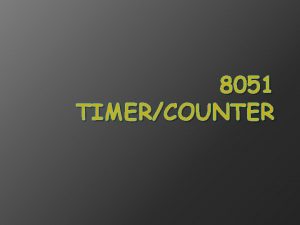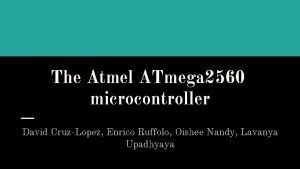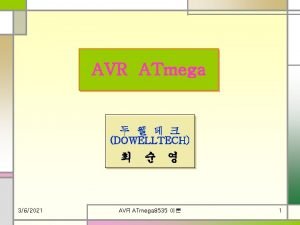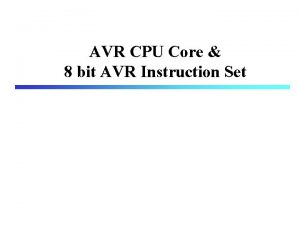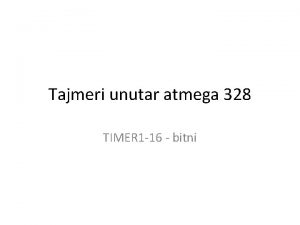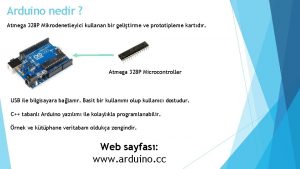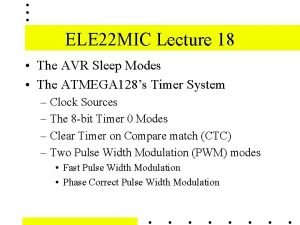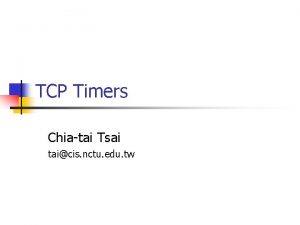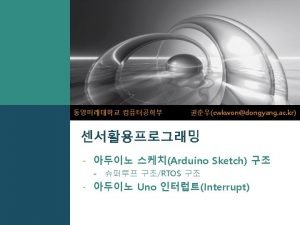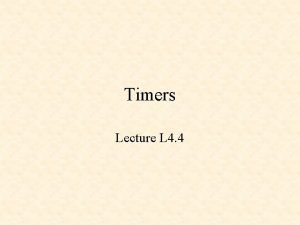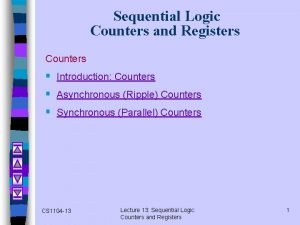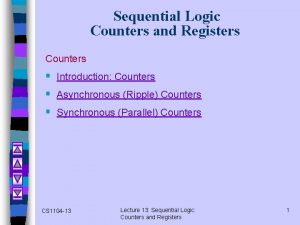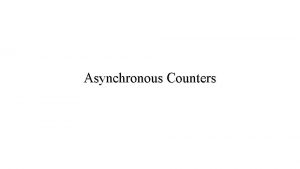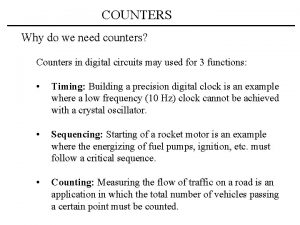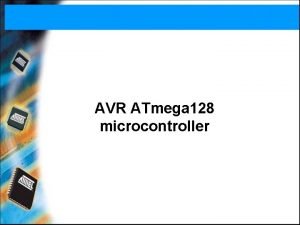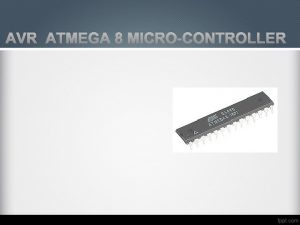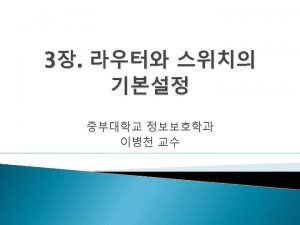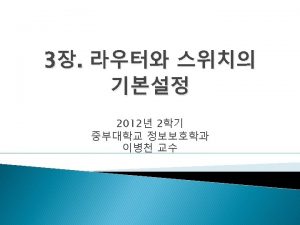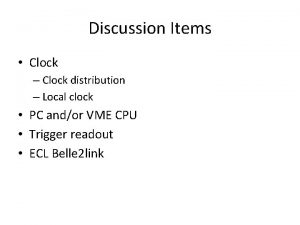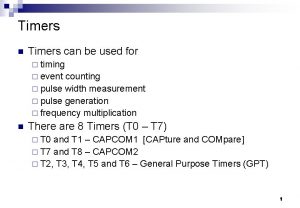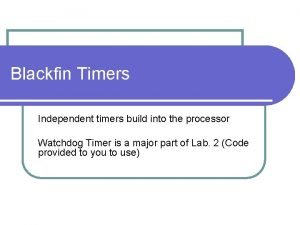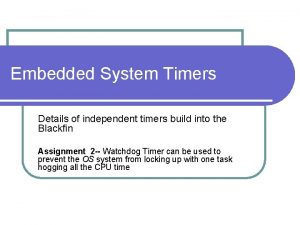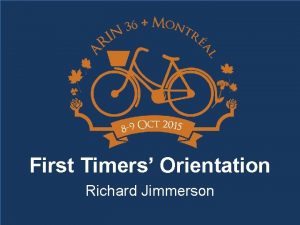Timers Counters Clock sources ATmega 16 has 3





















- Slides: 21

Timers /Counters

Clock sources ► ATmega 16 has 3 timers: timer 0 (8 bit), timer 1 (16 bit) and timer 2 (8 bit). ►Clock sources for these timers/counters are either internal (prescaled clock) or external. ►Timer 0, 1 external clock sources are synchronous produced by edge detection of input signals on pins PB 0, PB 1 sampled once every system clock cycle. On the other hand external clock for timer 2 is asynchronous where a crystal can be connected between the TOSC 1 and TOSC 2 pins (PC 6, PC 7) to serve as an independent clock source that can be prescaled. ►Definitions: Bottom Count = 00 Max Count = FF (or FFFF for timer 1) Top Count = Count at which timer is cleared to zero and is either FF (FFFF) or = Output Compare Register (OCR).

Simple Block Diagrams (Counter Unit) Timer/Counter 0

Simple Block Diagrams (Counter Unit) Timer/Counter 1

Timer/Counter 2

Output Compare Unit Timer 0 & 2

Timer 1

Modes of operation All 3 timers share 4 modes of operation but timer 1 has a 5 th mode. These 4 modes are: 1. Normal: In this mode the counting direction is always up, and no counter clear is performed. TOV=Timer/Counter Overflow Flag 2. Clear Timer on Compare Match (CTC): § In CTC mode the counter is cleared to zero when the counter value (TCNT) matches the Output Compare Register (OCR) [or also the Input Compare Register (ICR) by timer 1]. §The output compare pin can be set to toggle on each compare match. §This mode simplifies the operation of counting external events. § An interrupt can be generated each time the counter value reaches the TOP value.

Compare Match Output Unit o OC pin is connected to OC Register if either bit COMn 0, 1=1 also if both bits COMn 0, 1 = 0 no action takes place on OC Register on the next compare Match. o Timer 1 has two such units

PWM-Modes of operation 3. Fast PWM q single slope. q uses interrupt to change top. q Preferred by Power regulation or DAC. by Timer 0 & 2 by Timer 1

4. q q Phase Correct PWM Mode: double slope. OCR updated at top thus unsymmetrical output pulses (see mode 5). use interrupt to change top. Preferred by Motor Control. by Timer 0 & 2 by Timer 1

5. Phase and Frequency Correct PWM Mode (only by tim 1): q q double slope. OCR 1 updated at bottom thus symmetrical output pulses. use interrupt to change top. Preferred by Motor Control.

Input Capture Unit by timer 1 • The input Capture unit captures external events and It writes the 16 -bit value of the counter (TCNT 1) to the Input Capture Register (ICR 1), and the Input Capture Flag (ICF 1) is set. • The Noise Canceller function requires four successive equal valued samples of the input for changing its output. Its Output is therefore delayed by four Oscillator cycles. • If enabled, the Input Capture Flag ICF 1 generates an Input Capture interrupt.

Input Capture Unit by timer 1 (Contd. )

8 -bit Timer/Counter Register Description Timer/Counter Control Register – TCCR 0 Force Output Compare When writing a logical one to the FOC 0 bit, an immediate compare match is forced Compare Output Mode non-PWM Mode Fast PWM Mode Phase Correct PWM Mode

Waveform Generation Mode Bit Description

Timer Registers Timer/Counter Register – TCNT 0 Output Compare Register – OCR 0 Timer/Counter Interrupt Mask Register – TIMSK Timer/Counter Interrupt Flag Register – TIFR

Accessing 16 -bit Registers by timer 1 • The TCNT 1, OCR 1 A/B, and ICR 1 are 16 -bit registers. • The 16 -bit register must be byte accessed using two read or write operations. • A temporary storage register is shared between all 16 bit registers. • Accessing the Low byte triggers the 16 -bit read or write operation. When the Low byte of a 16 -bit register is written by the CPU, the High byte stored in the temporary register, and the Low byte written are both copied into the 16 -bit register in the same clock cycle. • Also when the Low byte of a 16 -bit register is read by the CPU, the High byte of the 16 -bit register is copied into the temporary register in the same clock cycle as the Low byte is read.

Timers Usage through Code. Vision Wizard

Delay Functions • These functions are intended for generating delays in C programs. • the file delay. h, located in the. INC subdirectory. must be #include -ed before using the functions. #include <delay. h> …. /* 100μs delay */ delay_us(100); . . . /* 10 ms delay */ delay_ms(10); //This function automatically resets the //wtachdog timer every 1 ms by //generating the wdr (watchdog Reset) instruction

 Timer and counter programming in 8051
Timer and counter programming in 8051 Atmel atmega
Atmel atmega Basic features
Basic features Arduino atmega 8535
Arduino atmega 8535 Atmega lock bits
Atmega lock bits Atmega
Atmega Avr instruction set
Avr instruction set Atmega 328u
Atmega 328u Dac programming
Dac programming Atmega nedir
Atmega nedir Atmega sleep mode
Atmega sleep mode Fast clock to slow clock synchronization
Fast clock to slow clock synchronization Why is there 60 seconds in a minute
Why is there 60 seconds in a minute Print sources and web sources
Print sources and web sources Importance water resources
Importance water resources 40 timers hms kurs
40 timers hms kurs Idle timer expired
Idle timer expired 아두이노 다중 인터럽트
아두이노 다중 인터럽트 40 timers hms kurs
40 timers hms kurs Timer symbol in plc
Timer symbol in plc 24 timers mennesket
24 timers mennesket 40 timers hms kurs
40 timers hms kurs
